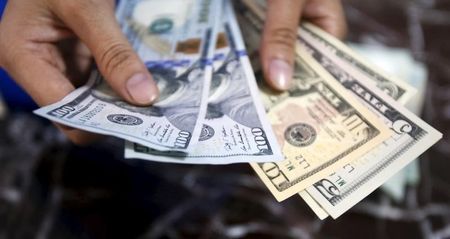
Investing.com – The US dollar rose Monday, remaining at elevated levels after the stronger-than-expected US payrolls data, while sterling continued to struggle for friends.
At 04:35 ET (09:35 GMT), the Dollar Index, which tracks the greenback against a basket of six other currencies, traded 0.4% higher to 109.930, after hitting its strongest level since October 2022 on Friday.
Dollar firm ahead of CPI
The dollar has received a boost after Friday’s data showed US job growth unexpectedly accelerated in December while the unemployment rate fell to 4.1%, leaving traders to scale back bets of Federal Reserve rate cuts this year.
Markets are now pricing in just 27 basis points worth of Fed rate cuts this year, down from roughly 50 bps at the start of the year.
“Friday’s strong US jobs release has provided another leg higher for the dollar. It is hard to see the dollar trend changing this week given the prospect of another strong set of US inflation data, which will increasingly raise the question of whether the Fed needs to cut rates this year at all,” said analysts at ING, in a note.
Wednesday sees the release of the December US CPI inflation release, and any upside surprise could threaten to close the door on easing altogether.
Sterling remains weak
In Europe, GBP/USD traded 0.7% lower to 1.2117, with sterling falling to a 14-month low, after dropping 1.8% last week, amid growing unease about Britain’s finances, prompting rising borrowing costs.
“Sterling continues to trade on a soft footing and its losses could extend this week,” ING added. “Wednesday will be the most important day for sterling given that is when December UK CPI data is released. Sterling may well get hit regardless of the number that comes out. Sticky inflation and what it means for the Bank of England cycle could spell more trouble for the UK gilt market.”
EUR/USD fell 0.4% to 1.0195, falling to its weakest level since October 2022, with the European Central Bank widely expected to ease interest rates by around 100 basis points in 2025, with most of the cuts coming in the first half of the year as inflation was seen heading to the bank’s 2% target by around mid-2025.
“With US rates rising and the dollar doing very well (up 8% since late September) it would not be a surprise to hear a few central bankers turning a little less dovish in order to provide some support to their beleaguered currencies,” said ING.
“However, in Hong Kong today, European Central Bank Chief Economist Philip Lane has preferred to say that without cutting rates further, the ECB inflation target would be at risk. It therefore seems that the ECB is not particularly worried by the soft EUR/USD levels as calls for parity grow louder.”
Yuan lacks support
In Asia, USD/JPY dropped 0.3% to 157.23, with volumes hit by the holiday in Japan, and as traders remain uncertain over a Bank of Japan meeting.
USD/CNY rose 0.3% to 7.3574, even as data showed China’s trade balance grew more than expected in December, aided by outsized exports.
But the reading was largely tied to exporters front-loading their shipments ahead of US President-elect Donald Trump imposing steep trade tariffs on the country. Trump – who will take office on January 20 – has vowed to impose tariffs on China from “day one” of his presidency.
This post is originally published on INVESTING.



